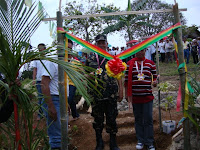SOUTH UPI, Maguindanao (MindaNews/27 Aug) -- In typical bayanihan fashion, residents of two remote barangays in this mountain municipality are building mini-hydroelectric plants to provide power to their homes, church and village officials said.
Barangays Itaw and Sitio Mafran in Barangay Pillar, populated mostly by Teduray natives and Ilonggo settlers, are so far from the town center that the province-wide electric cooperative could no longer provide electricity there. People take either horses or motorcycles to get there; for those with no money to pay, the only way is to hike,
according to Fr. Aliki Langi, the parish priest.
Although set to be inaugurated on Sept. 29 (for Itaw in time for the feast of St. Michael) and 30 (for Mafran) yet, residents of Mafran have been enjoying electricity these past few days, said Fr. Lionel Mechavez, Langi's buddy in the Marist Mission South Upi. "In fact, they had a disco last Sunday," he said when interviewed at the parish Wednesday evening.
Langi, a Tongan priest, said that October last year the church wanted to do some projects for the poor people of the villages, who are mostly small-time farmers. "We asked them what they need most, and the unanimous reply was electricity," he added.
It may sound impossible considering the staggering cost of putting up power lines in the mountains populated by poor people, but residents in these villages are lucky because an Indian engineer named Nick Govind provided the technology. Govind used to live in New Zealand with his Teduray wife Wing-wing, but moved to a neighboring barangay about five years ago, Langi said.
"Govind has been running his own mini-hydro plant for four years now," the priest said.
"Govind designed the plants, even built the turbines himself in a machine shop in Cotabato City," said Mechavez.
Other hydro plants may cost millions or even billions of pesos, but the ones in South Upi cost very little.
Through the help of the Cotabato Council for Justice and Peace, the Australian Embassy donated P275,000 for both projects. Barangay Itaw donated P100,000 and the Marist Mission donated P80,000. Barangay Pillar also donated 25 kilograms of nails. Govind did not charge a fix amount for his contribution, so he receives whatever amount the church and the community would give him, Langi said.
But residents of both villages donated their labor for free since construction started last December. "Everyday, 10 to 15 people take turns working on the construction of the plant. Another set prepares lunch, snacks and coffee," Langi said.
"Even children came to help, throwing stones into the tank's foundation just so they could claim later when they grow up that they helped in building the power plant," said Renan Laurente, a lay worker in the parish.
The Itaw plant is rated at 15 kilo volt amperes (kVA) and will be capable of supplying electricity to the 200 households in the area.
Fifty houses now have electrical wirings and bulbs already installed.
"But we are still fixing a leak on the tank, and this should be ready for the Sept. 29 launch," Langi said.
The one in Mafran is only rated at 2kVA, but good enough for the 75 households in the village with the residents' simple needs, Mechavez said. In a text message sent this afternoon, he said that 30 houses have been enjoying electricity since four days ago.
Itaw barangay chairman Julie Blanco, who farms rice and corn, said he is planning to put up a small ice plant as a business.
He said he would be saving a lot of money should electricity start running in his village.
For now, his generator consumes about three liters of diesel fuel for the three hours that he is using it almost every day to provide light for his home.
But in the mountains of South Upi, diesel costs about P50 a liter. "I expect to pay P50 to P100 a month once electricity becomes available," he said.
Barangay councilor Juanry Sangacina -- who helped mix cement, carry sacks of sand and cook lunch for the workers -- is excited to buy a television set once the hydro plant starts running. He is itching to watch ABS-CBN and GMA on a regular basis.
But while residents are excited over the mini-hydro projects, Mechavez is having headaches studying how to make operations sustainable. After all, they are starting everything from scratch, with no model to pattern their operations from.
They know they need to operate as a cooperative, the path taken by virtually all rural electric utilities in the country. But they do not have any contact yet with the National Electrification Administration, the government agency tasked for this job.
The church in South Upi, however, has little experience on cooperatives, Mechavez stressed. For three years now, the Marist Mission has helped in the organizing of a cooperative in another village, Balud. It started with a P50,000 capital -- half from the
cooperators, and half from the church's social action fund. It has been running smoothly to this day.
"But it is a consumer cooperative that involves buying and selling, which is so different from running an electric utility," Mechavez said.
Thanks to wireless Internet access from the mountains of South Upi, Mechavez is currently doing research on how to issue bills to electric consumers, how to do accounting for an electric cooperative, and how to ensure that their operations will be sustainable for the years to come. (Bobby Timonera / MindaNews)
 The sand for building the tank for the hydro, and cementing the pipe and other cement works was being brought up by horses from a river two or three kilometers away. The elevation also is quite steep from the river to the hydro side.
The sand for building the tank for the hydro, and cementing the pipe and other cement works was being brought up by horses from a river two or three kilometers away. The elevation also is quite steep from the river to the hydro side.




















